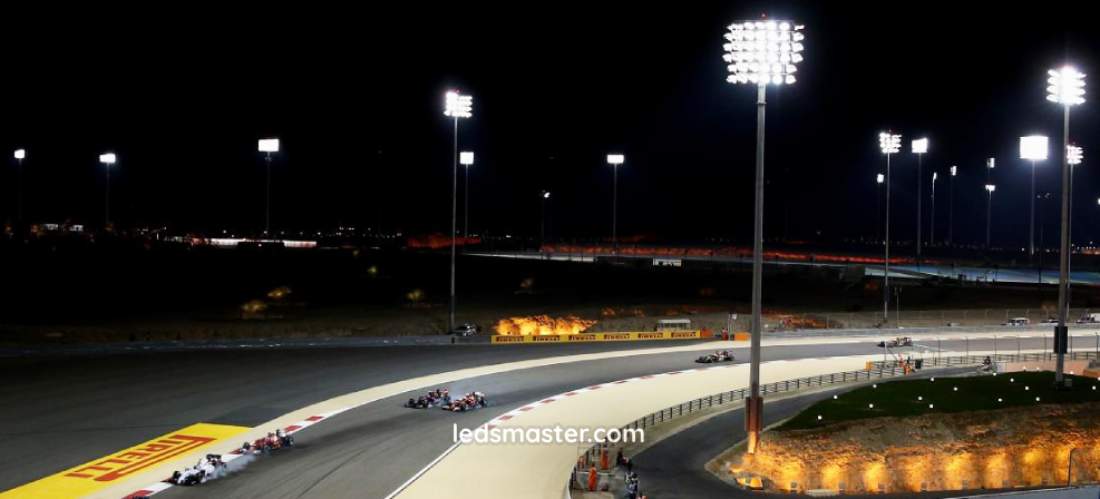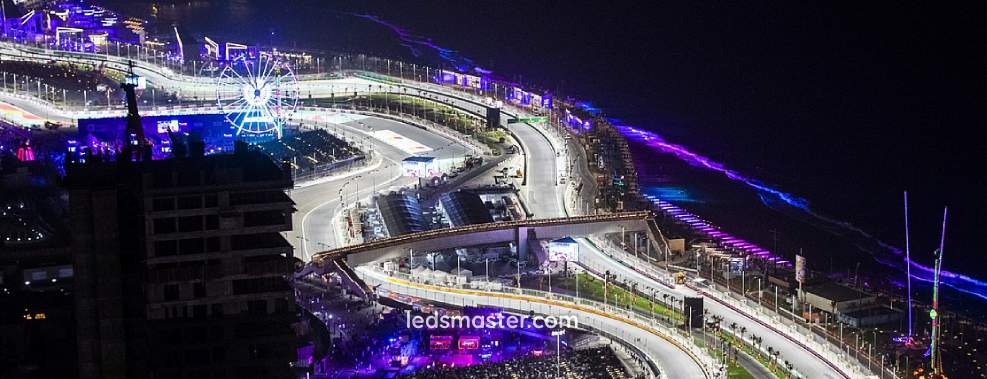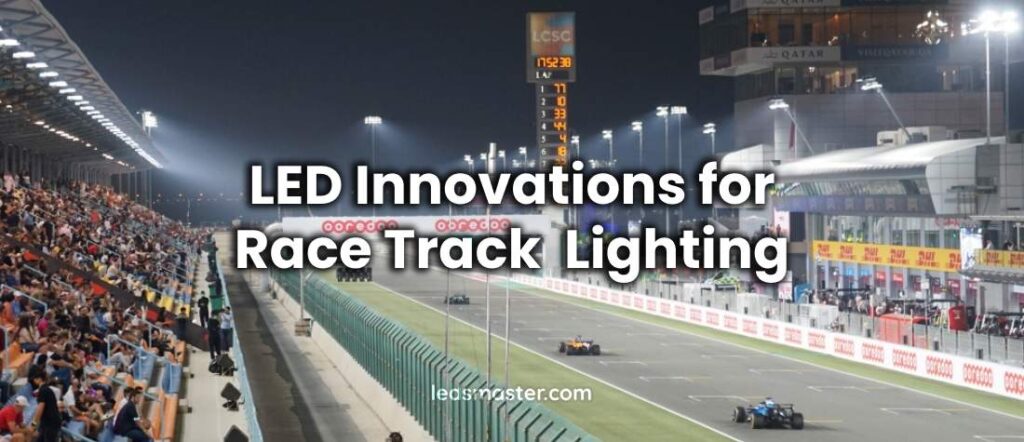Race track lighting design is crucial for ensuring optimal visibility, enhancing safety, and creating an exciting atmosphere for both participants and spectators. As motorsports like drag racing and monster truck shows evolve, the demand for advanced lighting solutions has become more pronounced. Modern race track lighting designs must address various challenges, from accommodating high-speed action to integrating with high-definition broadcasting requirements. LED technology has emerged as the leading solution, offering numerous advantages over traditional lighting systems.
Table of Contents
ToggleAdvantages of LED Lighting
Energy Efficiency and Longevity
The energy efficiency of LED lights represents a transformative leap in race track lighting design. Traditional lighting technologies, such as metal halide and halogen lamps, often waste a significant amount of energy as heat rather than converting it into visible light. In contrast, LEDs are engineered to be highly efficient, converting a larger proportion of electrical energy directly into light. This efficiency translates to notable cost savings on electricity bills, especially crucial for large-scale lighting setups like those found in race tracks where illumination needs are substantial.
The longevity of LED lights further enhances their appeal. With a lifespan that frequently surpasses 120,000 hours, LEDs offer a remarkable advantage over traditional bulbs, which typically require replacement much sooner. For race tracks, where the lighting infrastructure must endure harsh environmental conditions and frequent use, the durability of LEDs minimizes the need for regular maintenance and replacements. This extended lifespan results in significant cost savings over time, reducing labor and material expenses associated with changing lamps. Additionally, fewer replacements mean less downtime and disruption to racing events, maintaining consistent and reliable lighting throughout the year.
Uniform and Bright Illumination

Uniform illumination is a critical factor in race track lighting. Adequate lighting not only enhances visibility for drivers but also ensures that spectators have a clear view of the action, contributing to a more enjoyable experience. LED high mast flood lamps are particularly effective in achieving this goal. Their design allows for even light distribution, covering the entire race track with consistent brightness. This uniformity eliminates dark spots and shadows that could impair visibility and safety.
The ability of LEDs to provide strong, distal light is essential in race track environments, where the track surface must be illuminated evenly from end to end. This characteristic ensures that racers can see obstacles, track markings, and other crucial elements clearly, reducing the risk of accidents. For spectators, consistent lighting enhances the viewing experience by providing a clear and unobstructed view of the race. The uniformity of LED lighting helps to maintain a high standard of visibility, regardless of the time of day or weather conditions.
Anti-Glare and Color Control
Anti-glare features are a significant advantage of modern LED lighting in race track applications. Traditional lighting often produces glare that can be distracting and uncomfortable for both racers and spectators. This is particularly problematic during high-speed events, where clear visibility is crucial. LED flood lamps are designed with advanced optical technologies that minimize glare, ensuring that the light is directed precisely where it is needed without causing discomfort or impairing vision.
Furthermore, LED lighting systems offer unparalleled flexibility in terms of color control. Unlike traditional lighting, which typically provides a fixed color temperature, LEDs can be adjusted to different color temperatures and even change colors. This capability allows for dynamic and customizable lighting effects that can enhance the atmosphere of the race track. For televised or live broadcast events, the ability to create visually striking lighting setups can significantly enhance the viewer experience. Color control also enables the lighting to be adapted for different types of events or to match specific themes, adding an extra layer of creativity to race track presentations.
High-Speed and High-Definition Requirements
Race track lighting must be meticulously designed to meet the demanding standards of high-speed and high-definition photography. This requirement is especially crucial for events like drag racing, where vehicles achieve remarkable speeds, making every fraction of a second count. To ensure that the high-energy action on the track is captured with precision and clarity, lighting systems must be optimized for both high-speed and high-definition performance.
Non-Flickering Illumination for High-Speed Action
One of the most critical aspects of race track lighting is its ability to provide non-flickering illumination. In high-speed racing environments, where vehicles accelerate from 0 to 100 km/h in under a second, traditional lighting technologies may struggle to keep up. Flickering lights can result in motion blur and distortions in high-speed footage, detracting from the quality of the visual content.
LED lights excel in this regard, as they are designed to deliver stable, flicker-free illumination. The electronic components of LEDs operate at a high frequency, which prevents visible flicker even when viewed through high-speed cameras. This stability is essential for capturing clear and accurate slow-motion and high-speed footage, allowing viewers to see every detail of the action without interference from lighting-related artifacts.
Consistent and High-Quality Light

The ability to provide consistent and high-quality light is another crucial requirement for race track lighting. High-speed and high-definition photography demand uniform illumination across the entire track to avoid uneven lighting that could impact the visual quality of the footage. LEDs are particularly well-suited for this purpose, as they offer excellent light distribution and color consistency.
LED lighting systems are engineered to produce a steady and uniform light output, ensuring that every part of the track is illuminated evenly. This consistency is vital for maintaining visual clarity in both live broadcasts and recorded footage. By eliminating variations in brightness and color temperature, LEDs help create a seamless viewing experience that accurately represents the high-speed dynamics of the race.
Enhancing Viewer Experience
For televised or live broadcast events, the quality of the lighting directly affects the viewer’s experience. High-definition broadcasts require precise and vibrant lighting to capture the intricate details of the race. LED lights, with their ability to deliver bright, clear, and color-accurate illumination, enhance the overall quality of the broadcast, making the race more engaging and visually appealing for audiences.
The adaptability of LED lighting systems also allows for adjustments in color temperature and intensity, which can be tailored to meet the specific requirements of different camera setups and broadcasting standards. This flexibility ensures that the lighting enhances the visual presentation of the race while accommodating various production needs.
Durability and Weather Resistance
Race track environments, particularly those hosting high-impact events like monster truck shows and drag racing, present unique challenges for lighting systems. The lighting solutions employed in these settings must be robust and capable of enduring a range of physical stresses and adverse weather conditions.
Impact and Vibration Resistance
One of the foremost requirements for race track lighting is resistance to impacts and vibrations. During events like monster truck shows, where vehicles perform high-flying stunts and create substantial vibrations, lighting fixtures are subjected to significant physical stress. LEDs are inherently designed with durability in mind. They are constructed using rugged materials and robust housing that can withstand impacts and vibrations, ensuring that the lighting remains operational even under challenging conditions.
LED flood lamps are engineered with shockproof features that help them endure the intense vibrations of racing environments. This durability prevents potential damage to the lighting system, reducing the risk of malfunction or failure during critical moments of an event. The ability to maintain performance despite physical stress contributes to a reliable lighting setup that supports the smooth operation of the race track.
Weather Resistance
Weather resistance is another critical factor for race track lighting. Lighting fixtures are exposed to various environmental elements, including dust, dirt, rain, and extreme temperatures. Modern LED flood lamps are designed to be highly weather-resistant, incorporating features that protect against these elements.
Waterproofing is essential for race track lighting, particularly in areas prone to heavy rainfall or water exposure. LED lights with an IP (Ingress Protection) rating ensure that the fixtures are sealed against moisture and water ingress, preventing damage and maintaining performance even in wet conditions. Similarly, dustproof designs protect the internal components from dust and dirt accumulation, which can otherwise impair functionality and reduce the effectiveness of the lighting.
The ability of LEDs to operate effectively in a wide range of temperatures further enhances their suitability for race tracks. Whether exposed to freezing cold or sweltering heat, LED lights are designed to perform reliably, ensuring consistent illumination throughout the year.
Safety Considerations
Safety is a paramount concern in the design of race track lighting. Proper illumination is essential for both the participants and spectators to ensure a safe and enjoyable environment. The lighting system must provide clear visibility, reducing the risk of accidents and ensuring that all areas of the track are well-lit.
Enhancing Visibility
LED lights contribute significantly to safety by offering bright, uniform illumination. The even distribution of light across the track eliminates shadows and dark spots, providing clear visibility for racers and spectators alike. This uniform lighting is crucial for allowing drivers to see track markings, obstacles, and other racers clearly, thereby reducing the risk of collisions and improving overall safety.
Low Heat Emission
Another important safety consideration is the heat emission of the lighting fixtures. Traditional lighting technologies, such as metal halide and halogen lamps, generate a substantial amount of heat, which can pose a fire hazard, especially in environments with flammable materials or confined spaces. LEDs, on the other hand, emit very little heat compared to conventional lighting options. This low heat emission reduces the risk of fire and minimizes the thermal stress on the surrounding environment, contributing to a safer race track setting.
Robust Construction
The robust construction of LED lighting fixtures is crucial for preventing damage and ensuring longevity. LEDs are built to withstand the rigors of race track environments, including impacts from debris and vibrations from racing vehicles. The sturdy construction of LED lights helps to prevent damage that could compromise their performance or safety. Additionally, the use of anti-glare technologies in LED fixtures ensures that the lighting does not cause visual discomfort or distractions, further enhancing safety for both drivers and spectators.
Conclusion
The design of race track lighting plays a crucial role in enhancing the experience of both racers and spectators. LED technology has set a new standard for illumination, offering unparalleled energy efficiency, longevity, and brightness. With features like uniform light distribution, anti-glare optics, and high-speed compatibility, LEDs are ideally suited for the dynamic and demanding environment of race tracks. As technology continues to advance, race track lighting will undoubtedly evolve, providing even more innovative solutions to meet the needs of this exciting sport.

